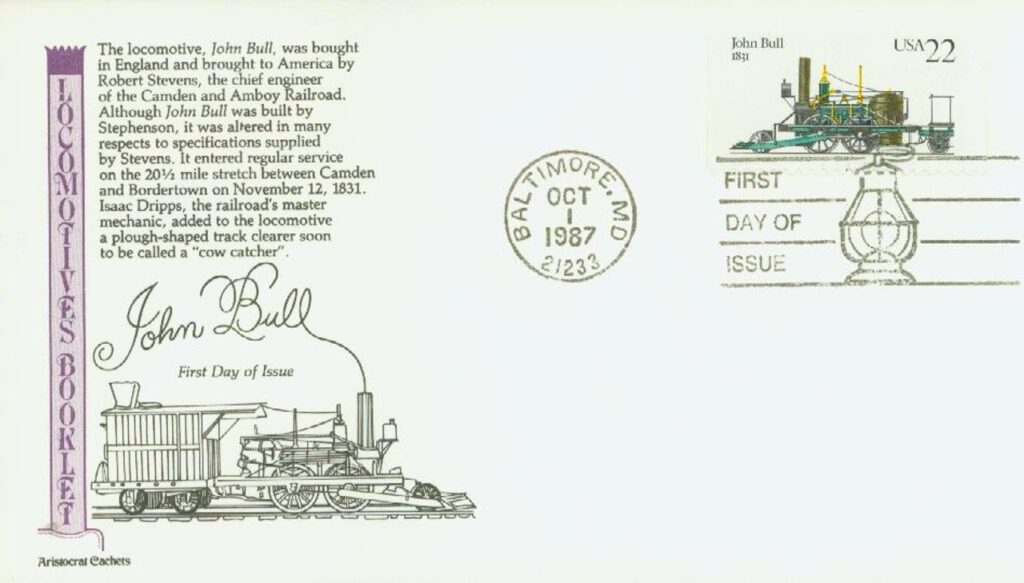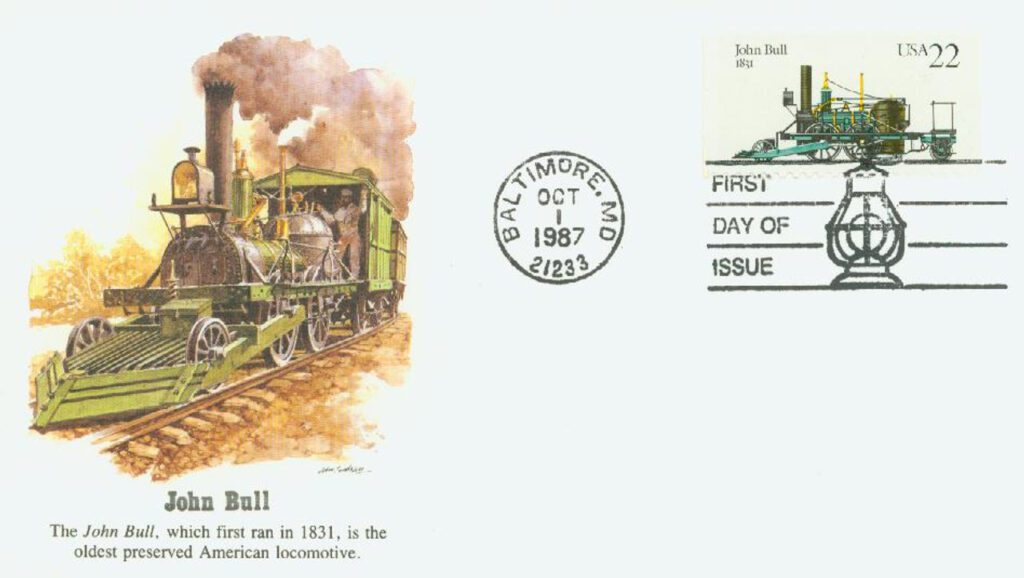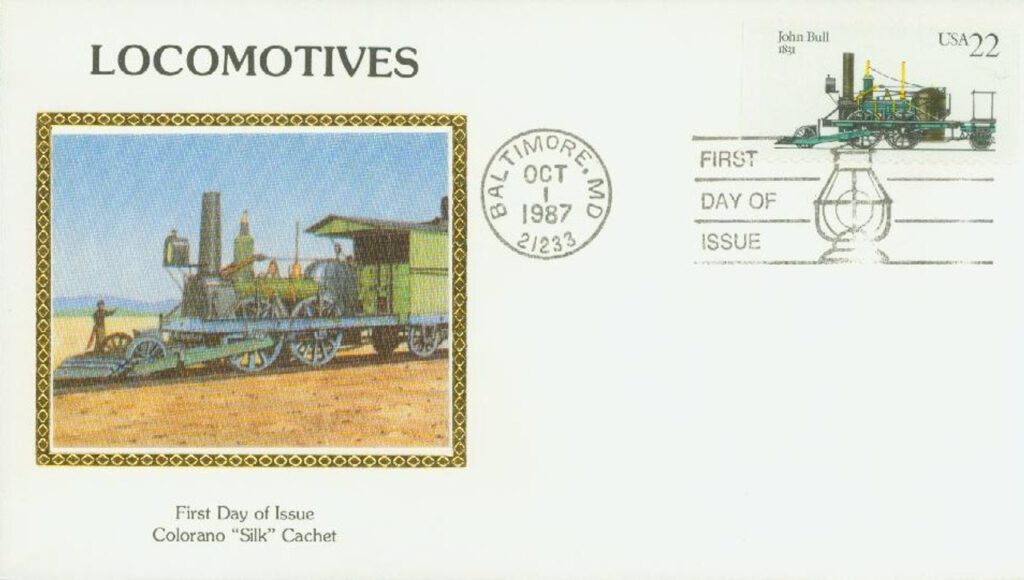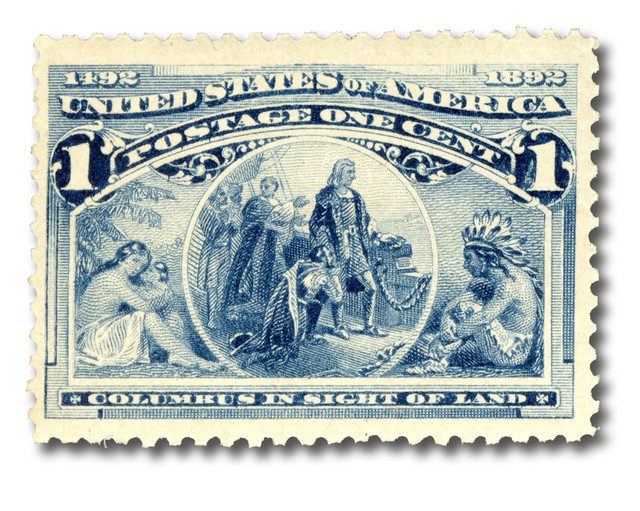
On September 15, 1831, the John Bull steam locomotive made its inaugural trip on New Jersey’s first railroad. It became a symbol of early railroad innovation and the beginning of a new era of transportation, marking a turning point that demonstrated the promise of steam power to move goods and passengers faster than ever before.
In the early 19th century, America was rapidly growing. Settlers were pushing westward, cities were expanding, and industry was beginning to take hold. However, the country’s transportation network lagged behind. Moving freight and passengers by wagon was slow, and canals, though useful, were limited to certain regions and seasons. Railroad technology had already begun to prove itself in Great Britain, where engineers like George Stephenson had developed efficient steam locomotives that were moving coal and passengers over iron rails. American entrepreneurs saw the potential and began looking for locomotives to use on their own railroads. The Camden and Amboy Railroad, chartered in New Jersey in 1830, aimed to connect the Delaware River at Camden with the Raritan River near New Brunswick. This line would help speed travel between Philadelphia and New York City. To power its trains, the railroad ordered a steam locomotive from the English firm of Robert Stephenson and Company.
As the first locomotive in the state, it was christened number one, and named Stevens, after Robert Stevens, the president of the C&A Railroad. The engine crews took to calling it the Old John Bull, after the popular British national symbol representing England. This was eventually shortened to John Bull, which became its new name. The engine arrived in pieces in the summer of 1831 and was assembled in Bordentown, New Jersey, under the supervision of Isaac Dripps, a young engineer who had never before seen a locomotive. Working carefully and learning as he went, Dripps put the engine together successfully. On September 15, 1831, John Bull made its first official run on the Camden and Amboy tracks. This historic event showed that steam power could work on American soil, where rail technology had to be adapted to rougher terrain and less precise construction than in Britain.
The railroad wasn’t complete yet, but Robert Stevens hoped to raise money to pay some debts. So he held a test run of the John Bull on short stretch of track that November. He invited members of the New Jersey legislature, local dignitaries, and Napoleon’s nephew Prince Murat. The prince’s wife, Catherine Willis Gray, rushed to get on the train before it left so she could be the first woman to ride a steam locomotive in America.
John Bull became the backbone of the railroad’s operations, hauling cars of passengers and freight. It underwent modifications to make it more suitable for American conditions, including the addition of a cowcatcher on the front to clear animals and debris from the track, a bell and headlamp for safety, and an enclosed cab to protect the engineer and fireman from the weather. These changes made the engine an early example of how American railroads customized equipment to meet their unique challenges. John Bull served the Camden and Amboy Railroad for more than three decades, proving the value of steam transportation as railroads spread across the country. By the time it was retired from regular service in 1866, it had already become a historic artifact in its own right.
Fortunately, the locomotive was preserved rather than scrapped. In 1884, John Bull was placed on display at the Smithsonian Institution in Washington, DC, one of the first major pieces of industrial history to be recognized as worthy of museum care. Over the years, it became a star exhibit, symbolizing the dawn of the railroad age in the United States. Remarkably, John Bull was restored to operating condition several times for special occasions. In 1893, it was steamed up for the World’s Columbian Exposition in Chicago, and again in 1939 and 1940 for the New York World’s Fair. Its most famous comeback came in 1981, when, to celebrate its 150th anniversary, John Bull was once again fired up and ran under its own power—making it the world’s oldest operable steam locomotive.
Today, John Bull is no longer operated, but it remains on display at the Smithsonian’s National Museum of American History, where visitors can see it up close. Its careful preservation allows people to appreciate the craftsmanship and ingenuity that went into early locomotives. More than just a piece of machinery, John Bull represents the confidence and ambition of a young nation eager to embrace technology and connect its people.
| FREE printable This Day in History album pages Download a PDF of today’s article. Get a binder or other supplies to create your This Day in History album. |
Discover what else happened on This Day in History.








Congratulations once more to Mystic Stamp for making my USA stamp collection much more meaningful. The information provided goes well beyond classic US history as the John Bull story is once again a magnificent example. Fortunately, I have most, not all of the stamps that have been reviewed. The series helps me to prepare an order for submitting to the great Mystic Stamp company. It should close the existing holes in my collection.
Railroads and trains, my two favorite subjects! A very interesting article as always. Thanks for the daily feeds.
I really do enjoy your “This Day In History”. One of the main reasons I began to collect stamps way back in 1945 was to learn a bit about American history. There is no better and less painful way! I am now the only one in Augusta, GA, who knows who the 13th president was—Millard Fillmore! I can still see his picture is on the 13 cent stamp in the Presidential Series. I still can recall all the others too! I hope you can keep up the good work. Sincerely, Bob Johnson
This daily history lesson about stamps is a wonderful idea. It is a great daily history lesson for young and old alike. Congratulations! I hope your business booms as a result. Jim
Really injoyable reading every day. The information enlightens me and helps me to add great stamps to my hobby. Collecting stamps was great fun when I was a boy. I am now retired and back in the game. 😀
I love trains. Thanks for this information of the “John Bull.”
Congratulations – great bit of information for our young (and old) stamp collectors….
the railroad mentioned in this history lesson is still in use today by the new jersey river line,at the interlocking at robbinsville n.j. the railroad runs north as a secondary railroad and no longer goes to amboy n.j.
These posts are really interesting and I would love to have a binder with the stories and a place to mount the stamps. Are you planning any such thing in the near future? Thanks to your staff for a great idea.
Tanks and Trains both began on the same day, just different years. Another good article by Mystic Stamp. Tanks for the memories.